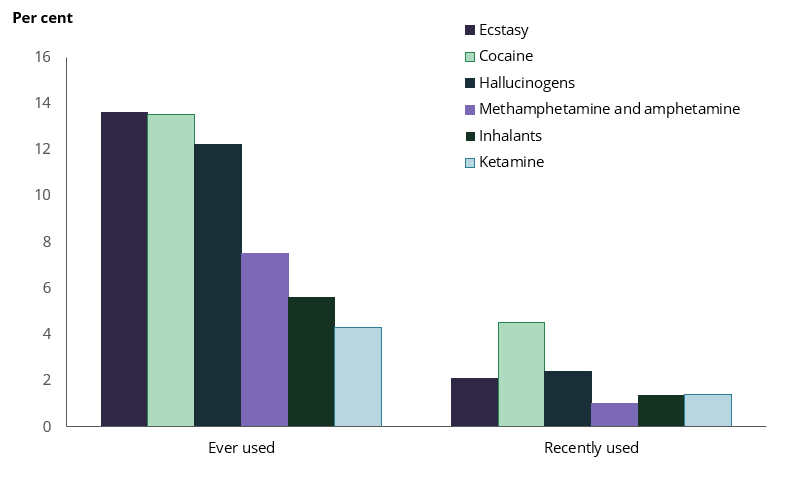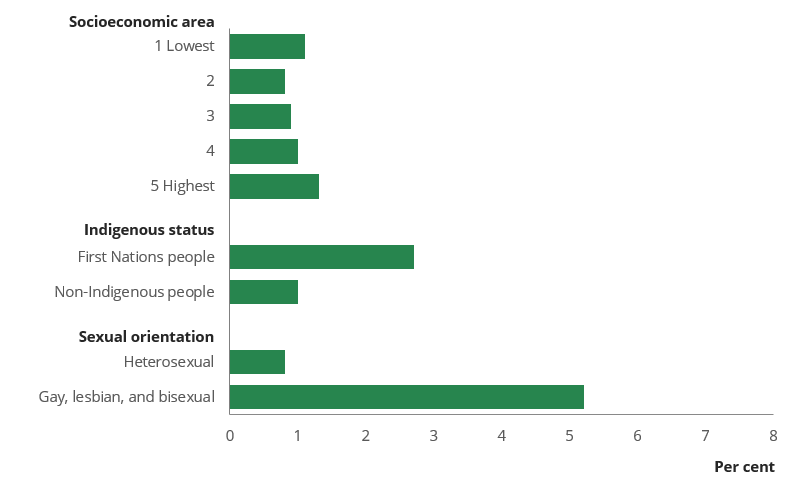Table 1: Summary of methamphetamine and amphetamine use among people aged 14 and over in 2022–2023Lifetime use | 7.5% (1.6 million people) |
|---|
Recent use1 | 1.0% (200,000 people) |
|---|
Opportunity to use in the last 12 months2 | 3.8% |
|---|
Age group most likely to use | 20–29 and 40–49 (1.7%) |
|---|
Average age of first use | 22.2 years |
|---|
Table 2: Summary of methamphetamine and amphetamine use among people who had used it in the previous 12 months in 2022–2023Used monthly or more often | 37% |
|---|
Main form used | Crystal/ice: 43% |
|---|
Diagnosed or treated for a mental health condition | 44% |
|---|
High and Very high psychological distress | 44% |
|---|
1. Refers to use of methamphetamine and amphetamine in the previous 12 months.
2. Proportion of people who had been offered methamphetamine and amphetamine or otherwise had the opportunity to use methamphetamine and amphetamine in the previous 12 months.
Source: NDSHS 2022–2023.
Methamphetamine and amphetamine
The NDSHS asked about the use of methamphetamine and amphetamine (including the street names speed, crystal and ice) in 2022–2023. In 2019 and prior years, the NDSHS asked about the use of “Meth/amphetamines”, which also included the non‑medical use of pharmaceutical amphetamines, such as Ritalin (methylphenidate) and pseudoephedrine based cold and flu tablets.
This change was implemented to improve national estimates for use of methamphetamine and amphetamine and improve the understanding of the questions among people who had used methamphetamine and amphetamine.
The change represents a break in the timeseries. Results for methamphetamine and amphetamine in 2022–2023 should not be compared to meth/amphetamines results from previous survey waves.
Recent use is low, but lifetime use is high
In 2022–2023, approximately 200,000 people in Australia (1.0% of the population) had used methamphetamine and amphetamine in the previous 12 months. This is lower than many other illicit drugs, including inhalants, ketamine, and hallucinogens (Figure 1).
In contrast, lifetime use of methamphetamine and amphetamine was high. Around 1.6 million people in Australia (7.5% of the population) had used it in their lifetime, meaning more people had tried it than inhalants or ketamine (Figure 1).

Source: NDSHS 2022–2023, Tables 5.2 and 5.6.
People aged 40 and over were the most likely to have ever used methamphetamine and amphetamine (15.0%), while recent use was similar between people in their 20s (1.7%), 30s (1.5%) and 40s (1.7%). This is a different pattern of use to most illicit drugs, which were more likely to have been recently used by younger people than older people.
People mainly used crystal/ice in 2022–2023
Methamphetamine and amphetamine were largely used in two forms in 2022–2023: as a powder (speed) which is usually inhaled, and as a crystal (ice) which is usually smoked but may also be injected.
Among those who had used methamphetamine and amphetamine in the previous 12 months:
- Most had used both powder/speed (67%) and crystal/ice (55%) at some point in their lives.
- In the past 12 months, a similar proportion of people had used crystal/ice (49%) or powder/speed (47%) at least once (noting that people could have used both in the previous 12 months).
- More people said that they mainly used crystal/ice in the previous 12 months (43%) than powder/speed (31%).
This indicates that most people are likely to have used both powder and crystal methamphetamine and amphetamine, even if the main form being used is most likely to be crystal/ice.
Who was most likely to have used methamphetamine and amphetamine?

Note: Rates for First Nations people should not be directly compared to rates for non‑Indigenous people due to differences in the age structures between the two populations. Age standardised results can be found in the supplementary data tables.
Source: NDSHS 2022–2023, Table 5.90.
As with all illicit drugs, use of methamphetamine and amphetamine was not uniform across the Australian population (Figure 2). In particular:
- Around 1 in 20 (5.2%) gay, lesbian, and bisexual people had used methamphetamine and amphetamine in the previous 12 months. After adjusting for differences in age, gay, lesbian and bisexual people were 6.6 times as likely as heterosexual people to have done so.
- Trans and gender diverse people were 4.2 times as likely as cisgender people to have done so (*4.2%).
- In 2022–2023, 2.7% of Aboriginal and Torres Strait Islander (First Nations) people reported using methamphetamine and amphetamine in the previous 12 months. After adjusting for differences in age, First Nations people were 2.3 times as likely as non‑Indigenous people to have done so.
While the differences in use between socioeconomic areas were smaller, interesting patterns of methamphetamine and amphetamine forms emerged in 2022–2023. People who lived in the lowest socioeconomic areas (the 20% of areas with the highest level of socioeconomic disadvantage) were much more likely to have used crystal/ice, while people living in the highest socioeconomic areas (the 20% of areas with the highest level of socioeconomic advantage) were much more likely to have used powder/speed.
* Estimate has a Relative Standard Error between 25% and 50% and should be interpreted with caution.
Relationship with mental health
Illicit drug use and mental health
It is not possible to determine a causative relationship between mental illness, psychological distress, and illicit drug use. Illicit drug use and mental health have complex interactions that cannot be addressed in isolation (Department of Health and Aged Care 2017). For further information, see Mental health and drug use.
People who had recently used methamphetamine and amphetamine were more likely to report having a mental health condition, and to be experiencing High or Very high levels of psychological distress, than people who had recently used any other illicit drug.
People experiencing High and Very high levels of psychological distress were 4.8 times as likely to have used methamphetamine and amphetamine in the previous 12 months (2.9%) as those experiencing low levels of psychological distress (0.6%).
People who reported having been diagnosed with, or treated for, a mental illness in the previous 12 months were 3.9 times as likely to have used methamphetamine and amphetamine in the previous 12 months (2.7%) as those who were not (0.7%).


